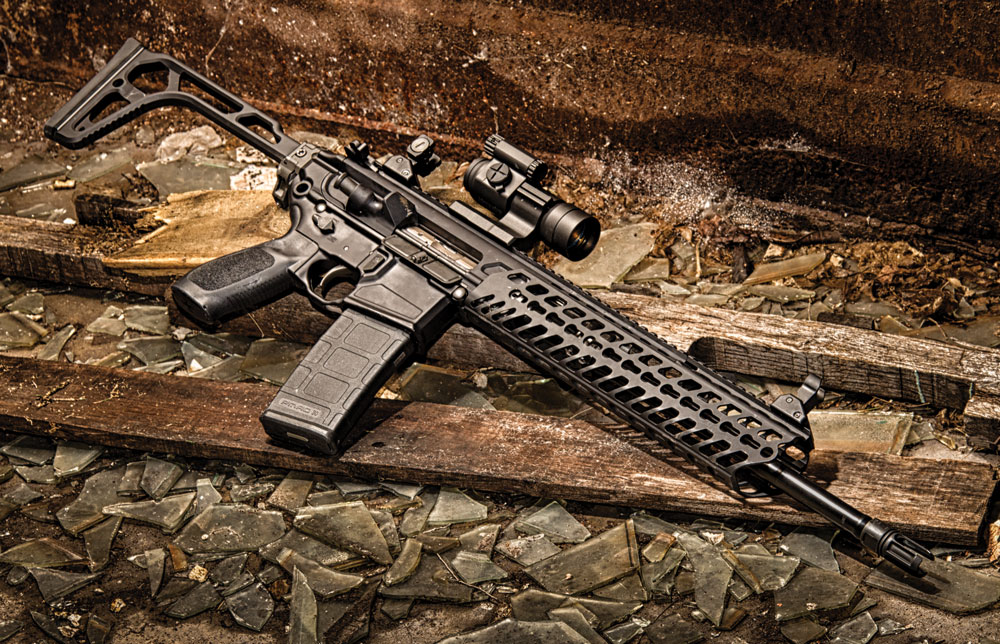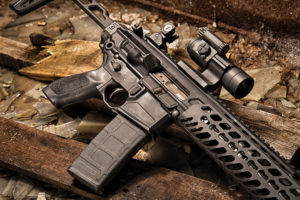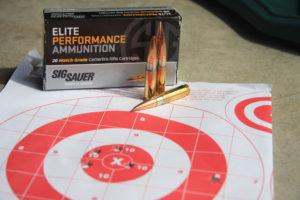

Pairing a modular design with top-class reliability, the new SIG Sauer MCX is ready for anything.
Formally introduced ahead of the 2015 SHOT Show in Las Vegas, the MCX was built to be a compact and lightweight, close-quarters battle (CQB) suppressed rifle optimized for the .300 AAC Blackout cartridge. Additional requirements for the platform included a modular design with a quick-change barrel system for easy interchangeability of calibers and barrel lengths, traditional AR-style controls for ease of use, the ability to utilize a folding stock, and a gas system that provided unparalleled reliability. In early 2015, SIG commercially released the MCX and made it available in three variations—a semi-auto rifle, a short-barreled rifle (SBR) and a pistol configuration.
With a weight hovering around 6 pounds for all three variants and an overall length of 35.75 inches for the rifle (28.75 inches and 26.625 inches for the SBR and pistol versions, respectively), the engineers at SIG excelled in the “compact” and “lightweight” categories. What’s more impressive, however, is that the company was able to meet all the other design goals as well.
Raise Your Sig Sauer IQ
Naturally, reaching these objectives doesn’t happen overnight. The MCX is the result of a rigorous development process on the part of SIG engineers.
“It was at least a 3- to 3½-year development that we’ve been working on the gun full time,” SIG Sauer rifle manager John Brasseur said. “We had probably about a year’s worth of tossing around what the spec was and nailing that down—exactly what would satisfy the customer and what they were looking for. Then it was 3 to 3½ years non-stop—conducting an engineering analysis and making a prototype, testing it and verifying it and going back and forth.”
Multiple Calibers, Multiple Configurations

One of the most impressive features of the MCX is its modularity. In addition to the .300 BLK it is primarily designed for, the MCX can easily configure to chamber and fire 5.56 NATO/.223 Rem. and the Soviet 7.62x39mm. The MCX features a lightweight aluminum KeyMod handguard that removes easily to reveal a simple, quick-change barrel system that consists of two bolts holding the barrel in place. One of the bolts helps push the barrel into the receiver, while the other tightens for a sure fit.
Alternating between .300 BLK and 5.56 NATO/.223 Rem. is as easy as swapping out barrels and the included operating rods; transitioning to 7.62x39mm adds a simple bolt face change to the process.
The op rods are designed to adjust the positioning of the gas block to ensure reliable performance with the given cartridge. The 5.56 NATO and 7.62x39mm op rods create a piston system that has a length similar to a carbine-length gas system in standard ARs, while the .300 BLK op rod produces a length similar to a pistol-length gas system, which is necessary for subsonic loads. Barrel twists are 1:6 inches for the .300 BLK, 1:7 for the 5.56 NATO, and 1:9.5 for the 7.62x39mm.
The MCX rifle reviewed for the magazine came with a long KeyMod handguard, but this can be replaced with a shorter variant, or a suppressor-width option if the user chooses. The short KeyMod handguard comes standard on SBR and pistol variants, while the suppressor-width option places the silencer inside as opposed to forward of the handguard. A carbon fiber choice is also listed on SIG Sauer’s website.
Because of its design requirement to utilize a folding stock, SIG’s engineers had to remove the buffer tube found on traditional ARs. To accomplish this, they developed a unique recoil assembly that places the recoil springs above the bolt carrier group (BCG). While this system offers other benefits, such as an altered recoil impulse and increased durability, it also removes the restriction of using a buffer-tube-style stock. SIG is offering several different options, but the rifle reviewed for the magazine came equipped with the company’s low profile, skeletonized SAS folding stock, which is standard on the rifle version of the MCX.
A 16-inch or 9-inch barrel is available on factory models, with the rifle version utilizing the 16-inch barrel and the SBR and pistol variants featuring the 9-inch barrel. However, Brasseur said SIG will also likely offer 6¾-, 11- and 14-inch barrels as aftermarket options. There are also two different color options, black and Flat Dark Earth (FDE).
“I think we went through one day and we did all the different variations that we could do,” Brasser said. “Just with the MCX we were over 250, I think, by the time we got done.”
With the exception of the absent buffer tube, the MCX lower is basically identical to a standard Mil-Spec lower, which means users can replace SIG’s proprietary pistol grip or the Mil-Spec trigger as their preference dictates. Because it uses a Mil-Spec lower, shooters can also transfer their MCX upper to any standard AR lower and convert it to an MCX with the help of a SIG MCX Stock Kit.
Explore Related SIG Sauer Articles:
- Choosing the Perfect Concealed Carry SIG – Top Models to Consider
- Customizable SIG Sauer P365 Upgrades
- SIG 516 Patrol Review – A Tactical AR-15 for All Needs
- SIG Sauer P6 vs P225 – Key Differences Between Two Cold War Pistols
- SIG Sauer M17 Civilian vs Military – What Sets Them Apart?
- Kimber Micro 9 vs SIG Sauer P938 – A Detailed Comparison
Any Load, Any Way

The MCX is certainly remarkable, but modularity means nothing if the firearm isn’t reliable across the different configurations. One of the biggest challenges for SIG’s engineers during the development of the MCX was creating a gas system that could not only handle .300 BLK, 5.56 NATO and 7.62x39mm, but also perform when firing super and subsonic loads from a variety of different barrel lengths, and with or without a suppressor.
“Those variations in barrel length and caliber create huge issues for gas systems and consistency with different ammos—never mind when you go suppressed and unsuppressed,” Brasseur said. “Creating a gas system that was robust and would function with all ammos with and without a silencer, in multiple barrel lengths, was a feat in itself.”
To produce such a system, the engineers at SIG used various high-level modeling systems to essentially “map out” the pressures going down and also out of the barrel, as well as the energy needed to reliably cycle each round.
“We would do pressure testing on high-impulse rounds and low-impulse rounds and get different pressure curves for the different ammunition down the barrel,” Brasseur said. “And then [we] were able to take that map and apply that to the gas system and see dynamically what was happening and if it would function the gun.”
The result of all this testing and development is the gas-operated, short-stroke piston system that makes the MCX so unique, and so reliable with any load. Of course, there are other factors that contribute to long-term reliability and durability. On a rifle such as the MCX, which was required to have an upper receiver that could fire up to 50,000 rounds before failure, it is important for parts to last. The best way to ensure this is to use robust parts that can handle lots of abuse. For this reason, SIG used a replaceable steel cam-path insert instead of the traditional aluminum one to avoid excessive wear. The charging handle latches move over steel pins as opposed to aluminum pins, and the interchangeable feed ramp insert is also made of steel. In addition, all of these parts—along with the forward assist—are replaceable for easy repair.
Barrels for the SIG Sauer MCX are hammer forged and receive a nitride treatment for increased barrel life. The MCX also utilizes a fully locked and closed rotating bolt system with a bolt and carrier that have a Nickel Boron coating for enhanced durability.
Range Tested

The MCX was tested with four different loads. Two of these were supersonic loads; two were subsonic. Accuracy testing was conducted at 100 yards from a bench using a Caldwell Matrix rest. Accuracy was measured on four different five-shot groups for each load, and velocity was measured with a Competition Electronics ProChrono chronograph from Brownells. For short-range target shooting, an Aimpoint ACO and MCX factory-installed, flip-up iron sights were used. For accuracy testing, a Nightforce Competition 15-55x52mm scope was utilized.
Of the loads tested, the SIG Sauer 125-grain Elite Performance supersonic load produced the best accuracy, with an average group of 1.59 inches and a best group of 1.01 inches. The Hornady 110-grain V-MAX supersonic load yielded the best single group overall at 1 inch. Average velocity with the supersonic Elite Performance was 2,189 fps with a standard deviation of 17 fps and an extreme spread of 39 fps. The V-MAX was the fastest, producing an average velocity of 2,369 fps with a standard deviation of 19 fps and an extreme spread of 48 fps.
Parting Shots
The SIG Sauer MCX is without question one of the most adaptable and customizable firearms currently available. It promises shooters the ability to easily transition between three different popular cartridges using supersonic or subsonic loads—with or without a suppressor—and it has an innovative and reliable gas-piston system that makes all of these things possible.
The MCX is primed for user-customization, with ample optics options available courtesy of 17¾ inches of available rail space up top, a KeyMod handguard for accessories, and several unique folding and expanding stock options from SIG. The MCX is a modular, multi-caliber weapon platform that users can transform into whatever they need it to be, and at a price of $1,866, it is also reasonably attainable for many shooters.
SIG SAUER MCX
Type: Gas-piston, semi-automatic
Caliber: .300 AAC Blackout, 5.56 NATO/.223 Rem., 7.62x39mm
Barrel: 16 in., 1:6-in. twist (1:7-in. for 5.56 NATO; 1:9.5-in. for 7.62x39mm)
Weight: 6 pounds (5.75 pounds for SBR and Pistol Variants)
Handguard: Aluminum KeyMod
Stock: SIG SAS folding stock
Grip: SIG Sauer proprietary grip
Trigger: Mil-Spec AR trigger
MSRP: $1,866
Manufacturer: SIG Sauer; SigEvolution.com
This article appeared in the Fall 2015 issue of Gun Digest the Magazine.
Raise Your Sig Sauer IQ:
- Sig Sauer Pistols
- P225-A1
- P320
- P516
- P220
- P320C
- 516 Patrol Rifle
- P250
- P6
- M17 Civilian Variant
- P938
- P365
- P226
- P290RS
- MCX Rattler

Next Step: Get your FREE Printable Target Pack
Enhance your shooting precision with our 62 MOA Targets, perfect for rifles and handguns. Crafted in collaboration with Storm Tactical for accuracy and versatility.
Subscribe to the Gun Digest email newsletter and get your downloadable target pack sent straight to your inbox. Stay updated with the latest firearms info in the industry.

![Best Concealed Carry Guns In 2025 [Field Tested] Wilson Combat EDC X9S 1](https://gundigest.com/wp-content/uploads/Wilson-Combat-EDC-X9S-1-324x160.jpg)


![Best 9mm Carbine: Affordable PCCs [Tested] Ruger Carbine Shooting](https://gundigest.com/wp-content/uploads/Ruger-Carbine-Shooting-100x70.jpg)
![Best AR-15: Top Options Available Today [Field Tested] Harrington and Richardson PSA XM177E2 feature](https://gundigest.com/wp-content/uploads/Harrington-and-Richardson-PSA-XM177E2-feature-100x70.jpg)
